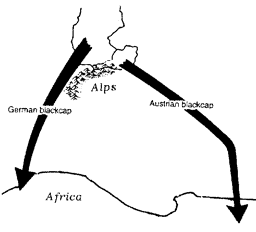 |
Science Frontiers ONLINE No. 77: Sep-Oct 1991 |
|
|
Do birds use genetic maps during migration?
 Routes taken by migrating German and Austrian blackcaps en route to Africa. Hybrids bisect these initial paths and would end up in the Alps. |
The problem has been exacerbated by recent experiments with German and Austrian blackcaps. These two common European warbler species take different routes to Africa in the winter. The Ger-man blackcaps fly southwest and the Austrian southeast--routes 50� apart. A. Helbig has crossed the German and Austrian blackcaps to see what route(s) their hybrid offspring would take. Curiously, they favored a route intermediate between those of their parents. The hybrids' route -- bisecting those of the parents' -- would take the hybrids right into the Alps, where survival would be unlikely. (Day, Stephen; "Migrating Birds Use Genetic Maps to Navigate," New Scientist, p. 21, April 21, 1991.)
Comment. The puzzle at hand concerns those purported genetic maps. Presumably, the hybridization of the two blackcaps involves the melding to two different, highly specific, maps and sets of migration instructions; possibly including compass directions (astronomically or magnetically determined), landmark locations, and even characteristic pathway odors. How can such instructions be combined (perhaps averaged) to draw up entirely new navigation instructions for a route the parents have never taken?